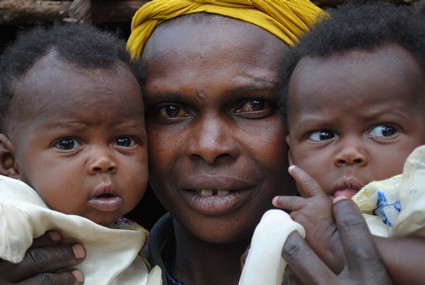I have lived in the developing world and seen the dire conditions in which millions of women give birth. In 2003, while working in Uganda near the border with Lake Albert and Congo to the west, I lived with a midwife named Florence.
She had few supplies and a decrepit scale to monitor the weight of the pregnant women who came for checkups, but she lacked nearly everything we take for granted in our own doctors’ offices. A few times, I helped her deliver babies in a small under-equipped building next to her home.
One particular evening, a woman came in to deliver her twins. Though almost 10 years ago, I can still quickly envision the unsterile, scant room and remember the nauseating smell of blood.
Fortunately, the woman survived and delivered two healthy babies, but I consider it almost a miracle after how much blood she lost in an area far from a hospital or proper health center, in a forgotten part of Uganda where tourists don’t roam.

As I left Uganda, I helped get electricity and water to Florence’s compound, but water and electricity alone won’t help Florence do her work successfully.
She needed family planning supplies to teach a variety of family planning methods. She needed pain medicine and disinfectant to sterilize the rooms properly. She needed a safe delivery kit to include a clean blade, a piece of string, soap and a piece of plastic to serve as the delivery surface.
Almost ten years later, this remote area of Uganda is still struggling to get much-needed family planning services to the communities. I wonder sometimes how many women and children have died because of the lack of family planning and health commodities.
Women around the world face obstacles that most of us can hardly begin to fathom. Lack of access to family planning leaves mothers in developing countries with no easy way to control the size of their families, and in the end, robs both the mother and her children of a better life, one that enables each to eat enough nourishing food and pursue the education that lifts communities out of poverty.







7 Comments |Add a comment
Thanks for all the great feedback and questions. I was unaware that this was posted until now. Compassion’s approach to this is great and is just what we want for all women… healthy timing and spacing of pregnancies. This is about family __planning__, not abortion. These two terms are not equal. Family “planning” allows women to have children at the rate that they desire, and gives them the chance to bring children into the world with a fighting chance, rather than bringing a child into the world without having the proper resources for survival. Family planning also saves women’s lives. Worldwide, over 215 million women want access to family planning supplies but do not have access and we want to change this alarming statistic. Male involvement in family planning is important, as is integration into other health services, including HIV/AIDS, nutrition and immunization. Compassion International is a member of Christian Connections for International Health. Learn more about CCIH’s work, including family planning, on facebook, twitter, linkedin and through our website: http://www.ccih.org. Thanks again for all the comments; rest assured that Compassion and CCIH are working for good to preserve life in all that we do.
Thanks, Jacquie and Nate. That is helpful (and comforting)!
When I read the words, “family planning”, my mind has been conditioned to think of Planned Parenthood, and abortion. Thankfully, that is not the intent here.
Compassion’s Child Survival program is very educational in so many facets of early life. With education, women can make better choices for themselves.
The Church in Uganda has a tough sell, to teach abstinence and monogamy.
Another tough sell is to the males, who must learn some personal self discipline too. In the Child Survival Center I visited, I don’t remember much emphasis on male responsibility.
By family planning, I assume you mean various birth control measures? Please be careful to provide only methods that prevent conception– not those that end a new life.
Laura, We had many questions about this on Facebook and I’ll share with you what was shared there by Chris, our Social Media Manager. He explained it best!
“The term family planning means different things to different people. As the author of the blog post works for another organization and doesn’t explicitly define what she means by family planning, I’m not able to say what she means precisely. However, I can help clarify Compassion’s position.
We do not provide money to purchase any form of temporary or permanent birth control, though our church partners may decide to obtain these resources from their governments or other organizations in their communities.
To clarify our use of the term “family planning,” what we teach to the moms in our Child Survival Program is adequate child spacing. Child spacing permits children to receive enough interaction with their mothers and not be weaned off of breastfeeding too quickly.
We desire that mothers in our Child Survival Program to have at least a two-year gap in between child births. This is to ensure that the child does not go undernourished and that the woman has enough time to recover before a new pregnancy.
However, we do permit our church partners to teach as they believe. Some of our church partners do teach natural forms of family planning, which includes basic education on human reproduction.
Our Child Survival Program beneficiaries are not forced nor required to practice family planning methods.
We strongly believe in the sanctity of life. A core part of our mission is to protect and preserve children’s lives at all stages of development. Therefore, implementing church partners do not condone or facilitate abortions. – Chris”
How can people in America help? Many of us sponsor a child, but honestly, how do we get these type of supplies to them? Can we send kits? As a mom, its tough to imagine your baby being born in these conditions.
Anyone can give to the Child Survival Program and that will make a difference. In case you are not familiar, the Child Survival Program is a program we created to care for moms and babies. Then we like to transition these little ones into the Child Sponsorship Program.
You can also let people know about a Child Survival Twitter Party we are having on Monday 7/30. The party is to raise awareness for babies and moms in our Child Survival Program.
Educating others about the issues moms and babies worldwide face is a BIG and easy way for many of us to help. Thanks for asking and please let me know if you have further questions!